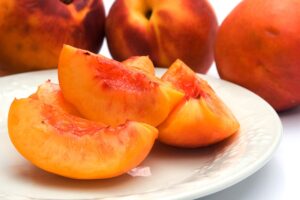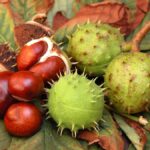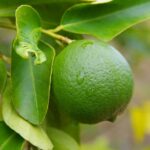Botanically speaking the nectarine is a variety of peach. But eaten out of hand or served at the table, the nectarine is both more and less than the peach.
Less: the nectarine is smaller than the peach; it is about the size of a plump plum.
The skin of the nectarine is fuzzless which makes it more toothsome than the peach. At the same time, the nectarine’s firm flesh—though succulent—holds together better than a peach when bitten into or sliced. (The term peach and nectarine lovers use for a fruit that disintegrates at your lips is “melting.” The peach is more melting than the nectarine.)
The nectarine and peach are interchangeable when it comes to recipes and cookery. Personal taste has a lot to do with which one you favor.
Besides eating out of hand, slice nectarines into pies, tarts, cobblers, compotes, fruit salads, or on to your breakfast cereal.
The name nectarine is derived from the Greek word nectar which means “sweet liquid.” That is a fair description of the nectarine’s juicy flesh: sweet. But it can sometimes also be tart and tangy.
Nectarines can be freestone—the flesh does not cling to the pit—or clingstone; it does.
Serving nectarines
Eat nectarines out of hand. Nectarines can also be cooked dried, canned, candied, or frozen.
- Prepare nectarines like peaches; they can replace peaches in most recipes.
- Slice nectarines into crêpes, cakes, pies, tarts, and cobblers, compotes, or fruit salads. Purée nectarines to use in sherbets, sorbets, ice creams, yogurts, mousse, puddings, and whips.
- Use nectarines to make jams and jellies.
Nectarine harvest season
Like peaches, the season for nectarines is spring and summer. The first nectarines will reach your farm market as soon as the weather warms enough in your region to ripen them up. That is usually by the beginning of June in the Northern Hemisphere—sometimes as early as April or May. The nectarine’s peak season is July and August.

How to choose nectarines
Select nectarines that are fragrant and not too hard. A ripe nectarine should give to gentle pressure at its seam. Avoid greenish-colored nectarines or those that are too hard, cracked, bruised, or have blemishes.
Choosing a ripe nectarine doesn’t have much to do with the color of the fruit. Skin color—usually yellow to deep yellow—and skin blush—from tinges of pink to deep red—indicates variety, not ripeness.
To find a ripe nectarine, look for plumpness and a slight give when you put pressure along the seam. Once you bite or cut into it, the flesh of the nectarine—which can be either white or yellow with tinges of red close to the stone–will be fragrant and juicy.
How to store nectarines
- Nectarines will keep for a few days at room temperature, slightly longer if refrigerated. Store nectarines loosely packed to prevent the spread of mold. Wash them just before using them.
- You can hasten the ripening of nectarines by placing them in a closed paper bag.
- You can freeze nectarines: first blanch and peel them and remove the pits which can leave a bitter flavor if not removed.
- Use overripe nectarines to make a compote or for purée.
How to prepare nectarines
- To make peeling a nectarine easier, immerse it in boiling water for a minute and then cool it under cold water.
- Use peeled nectarines quickly or sprinkle them with lemon or lime juice or vinegar to avoid flesh discoloration.
Nectarine flavor partners
Nectarines have a flavor affinity for almonds, apricots, champagne, cherries, cream, ginger, honey, pistachios, plums, pork, poultry, red wine, sour cream, sugar, vanilla, walnuts, and white wine.
Nectarine nutrition
Nectarines are a good source of potassium and contain vitamins A and C.
About nectarines
Nectarines are deciduous trees that usually grow to about 16 feet (4.8 m) tall. The nectarine is less hardy than the peach. The fruit of the nectarine is smooth and shiny; there is no downy fuzz like you would find on a peach. On average, the nectarine is smaller than a peach—usually about 3 inches (7.5 cm) in diameter.
The nectarine is not a cross between a plum and a peach, as some say. The nectarine is a variety of peach.
The nectarine is native to China. Sometime around 2,000 years ago, Chinese farmers began to notice that some peaches occasionally spontaneously produced nectarines. (Charles Darwin noticed the same thing much later.) In time, nectarines were cultivated to become their own peach variety. Still even today, almost anywhere in the world you go where they grow peaches, there will be spontaneous, local versions of the nectarine.
In 1857, the American horticulturist A.J. Downing noted that were 19 varieties of nectarines in North America. Today, there are more than 100 nectarine cultivars.
The botanical name for a nectarine is Prunus persica var. nectarine.
Related articles:
How to Grow Peaches and Nectarines
Planning the Home Fruit Garden
Garden Planning Books at Amazon:
- Vegetable Garden Almanac & Planner
- Kitchen Garden Grower’s Guide Vegetable Encyclopedia
- Vegetable Garden Grower’s Guide
- Tomato Grower’s Answer Book
More kitchen tips:
Bring your harvest to the table. Kitchen prep tips and easy recipes for the vegetables you grow. Click below for vegetable prep and recipes you can use now.
- Almonds
- Apples
- Apricot
- Aprium
- Artichoke
- Arugula
- Asparagus
- Avocado
- Bamboo Shoots
- Banana
- Basil
- Beans, Dried
- Beans. Long
- Beans, Shell
- Beans, Snap
- Beets
- Bitter Melon
- Blackberry
- Bok Choy
- Broccoli
- Broccoli Raab
- Brussels Sprouts
- Cabbage
- Cardoon
- Carrots
- Cauliflower
- Celeriac
- Celery
- Chard
- Chayote Squash
- Cherimoya
- Cherries
- Chestnut
- Chickpea
- Chinese Cabbage
- Chives
- Cilantro
- Citron
- Clementine
- Collards
- Coriander
- Corn, Sweet
- Corn, Baby
- Corn Salad, Mache
- Cranberry
- Cress
- Cucumber
- Daikon
- Dandelion
- Dill
- Eggplant
- Endive, Belgian
- Endive and Escarole
- Fava Beans
- Fig
- Florence Fennel
- Garlic
- Ginger
- Grapefruit
- Grapes
- Guava
- Horseradish
- Jerusalem Artichoke
- Jicama
- Jujube
- Kale
- Kiwifruit
- Kohlrabi
- Kumquat
- Leeks
- Lemongrass
- Lemons
- Lettuce
- Lime
- Mache (Corn Salad)
- Mandarin Orange
- Mango
- Maple Syrup
- Marjoram
- Melons
- Michihili
- Mint
- Mizuna
- Mushrooms
- Mushrooms, Cremini
- Mustard Greens
- Napa Cabbage
- Nectarine
- Okra
- Olives
- Olive oil
- Onions
- Oranges
- Oregano
- Parsley
- Parsley Root
- Parsnips
- Passion Fruit
- Pawpaw
- Peaches
- Pears
- Peas, Garden Snap
- Peas, Snow
- Pei Tsai
- Peppers, Chili
- Peppers, Sweet
- Persimmon
- Pineapple
- Pineapple Guava
- Plantain
- Plums
- Pluots
- Pomegranate
- Potatoes
- Prickly Pear
- Pumpkin
- Quince
- Radicchio
- Radishes
- Raspberries
- Rosemary
- Rhubarb
- Rutabaga
- Sage
- Salsify
- Sauerkraut
- Savory
- Shallots
- Sorrel
- Spinach
- Squash, Summer
- Squash, Winter
- Strawberries
- Sunchokes
- Sunflower
- Sweet Potato
- Swiss Chard
- Tangerine
- Taro
- Tarragon
- Thyme
- Tomatillo
- Tomato
- Turnip
- Turnip Greens
- Yams















